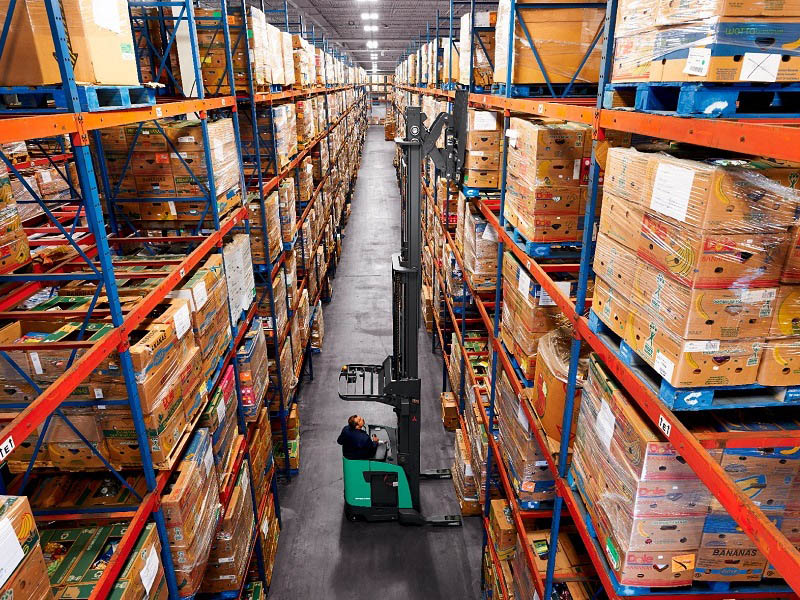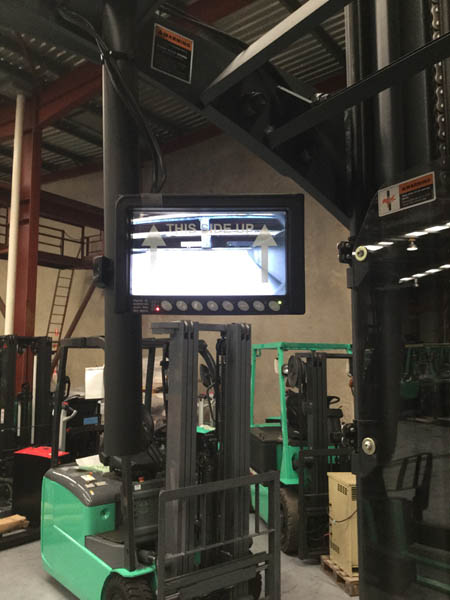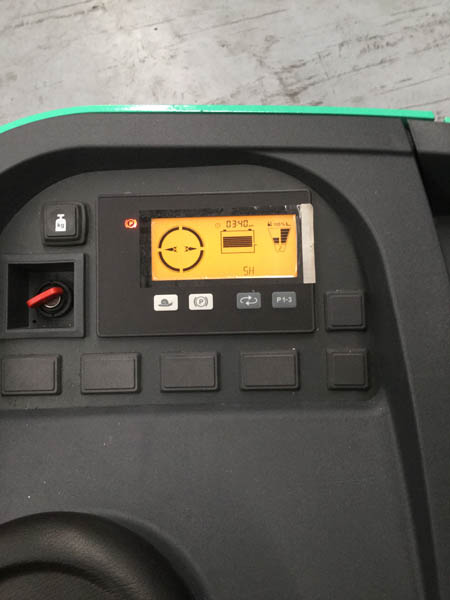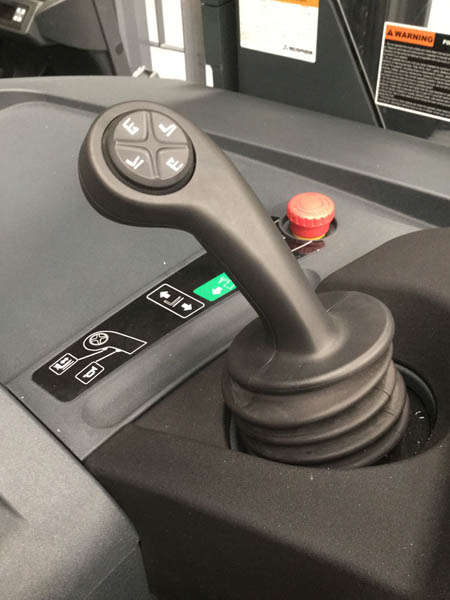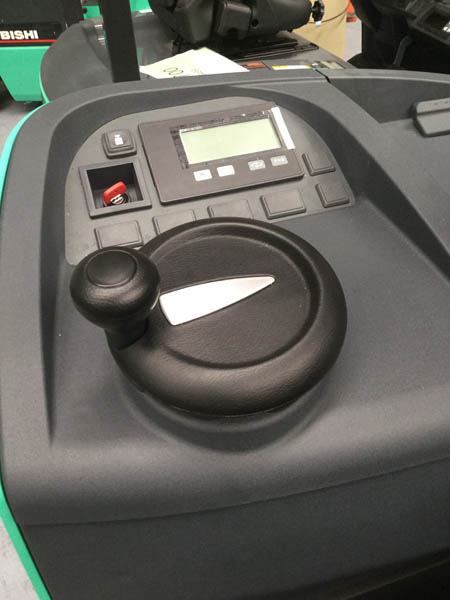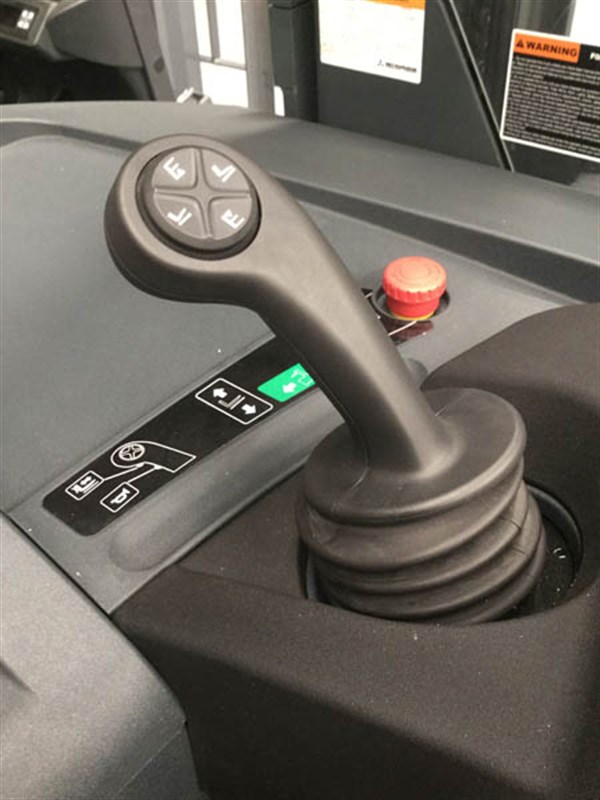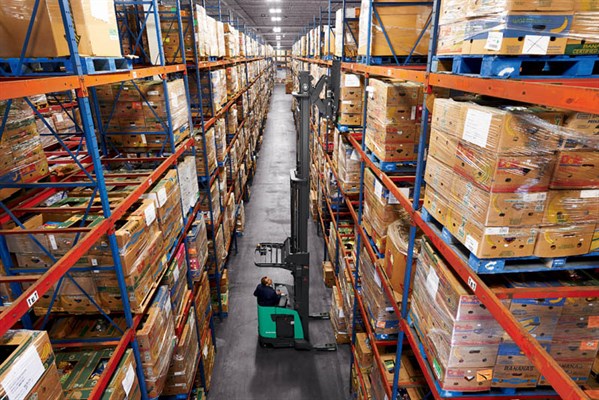The Mitsubishi EDR18N2 Pantograph reach truck makes a strong argument for vertical working.
Operating a forklift truck while sitting down can be a real pain. Being such a porker, I find all my belly flab gravitates down and after a short while it’s just plain uncomfortable.
But not so with Mitsubishi pantograph reach trucks. In these you get to stand up, look up and constantly turn your neck so your body gets exercise.
It’s almost like going to the gym while working. If you’ve decided to toss in your job as an Airbus pilot, the joystick control will make you feel right at home, providing you’ve piloted on the starboard side of the cockpit.
Pantograph trucks are way more popular in the United States than in Australia, where factories tend to favour single-depth stacking.
As Australian distributor MLA Holding’s Gary Hodge explains, if double stacking isn’t set up right there’s a lot of wasted effort retrieving the first pallet to reach the one behind. But if the stacking is for the same product then double stacking can free up a lot more floor space between aisles.
The range pf Mitsubishi Pantograph reach trucks comprises three models from 1.5 tonnes to 2.0 tonnes with a choice of single or double deep reach. The model I tested was the double deep reach EDR18N2.
Mitsubishi EDR18N2 Pantograph
All three trucks are powered by a 36-volt AC drive motor that through a ring gear rotates 360 degrees for steering and drive.
Unlike sit-down reach trucks such as the Mitsubishi RBF16CA, the drive motor is to one side so that only one wheel of the six (two rear and four forward) actually drives the truck.
This is done via a chunky 343x140mm cushion tyred-wheel with the other rear wheel being just a dolly unit.
Switching on the unit requires the emergency stop button to be lifted and the ‘ignition’ key turned to ‘on’.
The dash panel then lights up. A further safety device is that both the operator’s feet must be firmly on the cushioned floor to activate direction and fork control.
Controls
Steering is controlled via a small wheel operated by the left hand with a direction indicator in the compact dash that also shows the amount of battery charge left.
Because spinning the wheel can actually alter the truck direction without using the joystick control, it takes a while to master this action.
The oh-so-sensitive joystick on the Mitsubishi EDR18N2 Pantograph reach truck is an incredible piece of design.
By pushing it to the right the truck moves forward and left backwards with a loud beeping that sure impacts on my tinnitus. The four-axis thumb control in the top of the joystick handles fork angle and left/right fork side shift.
Pulling back on the joystick lifts the fork while pushing forward lowers it. There’s no tilt function for the mast itself so all the angling is done at the fork.
A small lever under the joystick crown controls pantograph in or out and below this is the horn button.
To the left of the joystick is a clip holder for documents and a small recess for a mobile phone and car keys. To the right of the joystick is a single drink holder.
The problem with deep stacking in a high reach situation is that it’s almost impossible to see where the pallet is in relation to its stacking location.
Cleverly Mitsubishi has overcome this by mounting a small camera alongside the right fork tine so operators can see where the fork is relative to the pallet.
Servicing and maintenance
A side-hinged panel opens to reveal the vertically mounted drive motor, which with its ring gear is sealed and should never need maintenance.
MLA had opted for the maximum battery capacity of 1, 120 amp/hours (six-hour rating), a simple lead-acid unit that had multiple connections to the wet cells for fast top-up. This unit slides sideways out of the truck for replacement.
Lead acid batteries are perfect for forklifts because they’re heavy and can be constantly trickle-charged to maintain full capacity without damage, something you definitely can’t do with lithium-ion batteries.
Performance
Standing up to operate a forklift truck sure is novel to me.
The waist support was very comfortable and after planting my feet firmly on the dead man switches, raising the stop button and turning the ignition key the dash lit up and I was ready for the experience.
Frankly, I love electric forklift trucks. The degree of control possible simply can’t be matched by comparable internal combustion (IC) units and like the Mitsubishi RBF16CA and FB25CA I tested earlier this year it was possible to control mast lift, pantograph reach and fork angle in millimetres and with no jerking.
Once I mastered the joystick all the operations it performs became second nature, especially as I could rest my arm on the padded support to the right of the joystick.
When the joystick was released while travelling forwards or backwards the truck quickly came to a hold but not abruptly, which could destabilise a pallet on high reach. It was great not having to worry about braking as the drive motor did it for me.
Initially I was a bit confused between looking at the fork tines or the camera but the vision of the latter was so good I quickly ended up using the camera to judge where the tines were relative to the pallet.
It’s a different experience watching tines slide into a pallet without actually looking up or down to see where they are.
Even with the mast near maximum reach and the pantograph fully extended the truck was stable with no sign of flexing through the pantograph scissors, though admittedly we didn’t have anywhere near maximum loading.
The tiny closed cone straddle wheel legs provided remarkable stability for their size, especially considering how narrow the truck was relative to reach height.
A nice touch was the soft landings as the mast lowered and pantograph retracted.
Combined with the precise mast, pantograph and fork control it’s possible to stack fragile items without fear of damage.
Looking upwards to make sure I didn’t clobber MLA’s warehouse ceiling approaching maximum reach the operator guard didn’t interfere with clear vision of mast height.
Standing up actually worked a treat as I was able to stretch occasionally and give my neck a workout by rapidly looking between the mast tip and the camera.
Verdict
The detail Mitsubishi has incorporated in such a compact truck is incredible.
Admittedly with its low ground clearance it’s strictly an indoors truck but the way the controls fall to hand is simply brilliant.
The camera eliminates the need for guesswork when extending the pantograph into a deep stack and apart from the (very) loud beeping in reverse the unit is very quiet in operation.
Mitsubishi EDR18N2 Pantograph specs
Make/model: Mitsubishi EDR18N2
Maximum load: 1,580kg at rated load centre
Load centre: 600mm
Maximum lift height: 11m
Free lift: 1.5m
Fork tilt angle: 3 degrees forward, 4 backwards
Overall mast height: 7.37m
Lifting speed: 380mm laden/600mm unladen per second
Lowering speed: 550mm per second
Minimum turning radius: 1.8m
Wheelbase: 1.56m
Overall length: 1.58m to fork face
Ground clearance: 61mm
Tyres (drive): 343x140mm
Tyres (caster/dolly): 180x100mm
Tyres (load): 127x92mm
Gradeability: 9 per cent laden/unladen
Truck weight: 3.35 tonnes
Battery weight: 1.05 tonnes demo truck
Drive motor: 4.5kW (60-minute rating)
Hydraulics motor: 20kW (5-minute rating)


